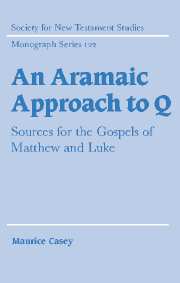Book contents
- Frontmatter
- Contents
- Preface
- List of abbreviations
- 1 The state of play
- 2 Method
- 3 Scribes and Pharisees: Matthew 23.23–36//Luke 11.39–51
- 4 John the Baptist: Matthew 11.2–19//Luke 7.18–35
- 5 Exorcism and overlapping sources: Mark 3.20–30; Matthew 12.22–32; Luke 11.14–23; 12.10
- 6 Conclusions
- Select bibliography
- Index of passages discussed
- Index of names and subjects
6 - Conclusions
Published online by Cambridge University Press: 22 September 2009
- Frontmatter
- Contents
- Preface
- List of abbreviations
- 1 The state of play
- 2 Method
- 3 Scribes and Pharisees: Matthew 23.23–36//Luke 11.39–51
- 4 John the Baptist: Matthew 11.2–19//Luke 7.18–35
- 5 Exorcism and overlapping sources: Mark 3.20–30; Matthew 12.22–32; Luke 11.14–23; 12.10
- 6 Conclusions
- Select bibliography
- Index of passages discussed
- Index of names and subjects
Summary
In surveying the history of previous scholarship in chapter 1, I showed that the Aramaic dimension of Q has never been properly treated, and is conventionally omitted. This is a remarkable fact. Most people have noticed that language is a significant part of culture, but the study of Q, like the study of Jesus in general, has proceeded as if this were not the case. I also showed in chapter 1 that the whole notion that Q was a single document written in Greek has never been satisfactorily demonstrated. The omission of the Aramaic dimension is one significant aspect of this, since it has prevented a proper critical assessment of those passages in which the material was transmitted in Aramaic, of which Matthew and Luke used or made different translations. It is not, however, the only significant defect in scholarship. The predication of a Q community, and attempts to portray Jesus as a Cynic philosopher are among other major problems. All these problems are related at a profound level. The omission of Aramaic is one aspect of a general failure to see the Q material within the culture in which it was produced. This general failure is behind most of the other serious problems.
- Type
- Chapter
- Information
- An Aramaic Approach to QSources for the Gospels of Matthew and Luke, pp. 185 - 190Publisher: Cambridge University PressPrint publication year: 2002



